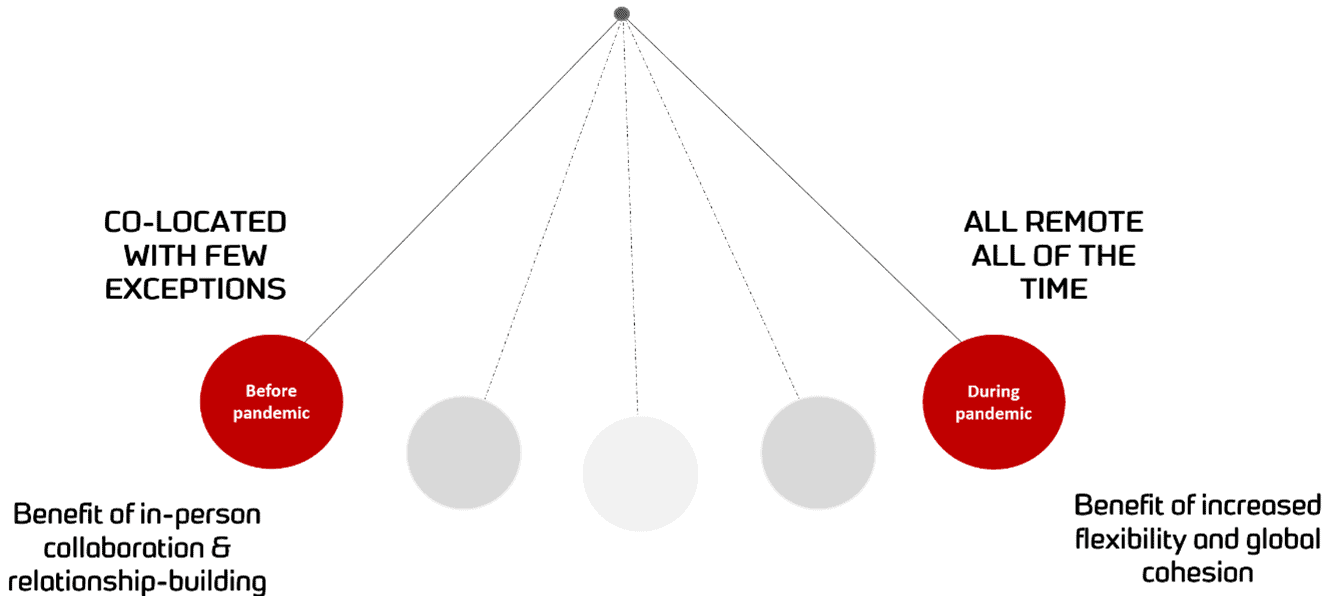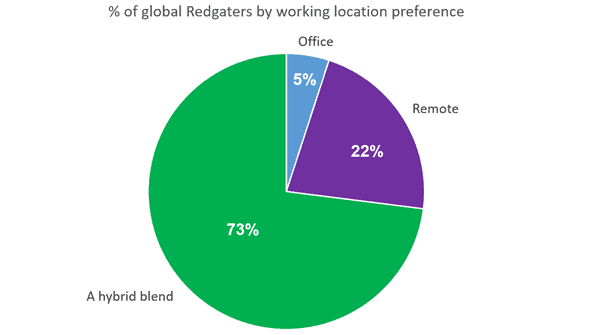Introducing Redgate’s flexible-hybrid working model
The world of work has changed dramatically over the last year and, at Redgate, we’ve been reflecting on what this might mean for our business, and the ways that we work together in the future.
From 2022 onwards, we’re aiming to offer Redgate staff a flexible-hybrid working model across our global organization. We want to build on the lessons we’ve learned from remote working during the COVID-19 pandemic, while continuing to enjoy the benefits of Redgate’s strong pre-pandemic culture and connections.
Our intention is to find a balance between co-located and remote working that allows everyone to do great work and ensures that individuals and the company can all thrive.
Our experience of remote working during the pandemic
In late March last year Redgate moved to full-time remote working in the space of a week in response to the pandemic. We were fortunate that we already had the people, plans and processes in place to make the transition successfully at very short notice.
Since then, we’ve better understood the benefits that remote working can bring – improved work/life balance, less time spent commuting, greater inclusivity and involvement for Redgate people working in our global offices, and more focused time free from distractions.
As well as learning a lot about working remotely, we’ve also learned how resilient we are as a company. Like many people, our employees have faced personal challenges such as child and family care, bereavement, isolation and anxiety during the pandemic. Their health and wellbeing always has been and always will be a priority for Redgate, and we’re really proud of how our teams have adapted and supported one another since March 2020.
At the same time, that sense of community is one of the many reasons why we’ve missed working together in a shared space. We also feel that we’ve lost some of the benefits that co-located work can bring – serendipitous conversations and knowledge-sharing, group ideation and creativity, and the kind of relationship-building that can be harder to do over Zoom (not to mention the well-documented risk of Zoom fatigue).
Internally, we’ve been using the analogy of a pendulum swing to describe the working styles that Redgate has tried out in recent years, and we believe that our post-pandemic sweet spot is likely to land somewhere between the two extremes.

Redgate’s plan for post-pandemic hybrid working
Our vision for the future of working at Redgate is to adopt a hybrid working model that balances the flexibility our people seek with the need to retain our collaborative culture and sustain a high-performing business.
We believe that this approach will best suit Redgate’s needs in the longer term. It will allow us to continue enjoying the benefits of remote working that many Redgate people have experienced, while retaining the option of in-person office working to strengthen relationships, help train and support new team members, and recapture the energy many of us gain from working together in the same space. The difference between this model and our previous working practices is that working together in the same space won’t be something we do all the time, or our default way of working.
Redgate isn’t alone in making this change following the pandemic. According to CompTIA’s IT Industry Outlook 2021 report, our decision to move to a flexible and hybrid working model mirrors anticipated shifts in workforce location throughout the wider technology sector:

The data that informed our decision-making
The data we’ve seen from our people and from our industry peers was already guiding us towards a hybrid working model. Almost 80% of Redgate’s people have stated in internal surveys that they’d like at least some access to office space, even if they only take advantage of this access occasionally. With only 5% of the company preferring a return to full-time office working, this data helped us rule out a move to fully remote working or a return to full-time co-located working.

After reviewing a number of different options for hybrid working, we were inspired by flexible hybrid models: hybrid working where the nature of the work dictates the location where the work is done. This is in contrast to static or synchronized hybrid models, where teams, individuals or the whole company are expected to be in the office on the same days each week.
We think the flexibility this hybrid approach offers is a good fit for Redgate’s post-pandemic vision. We want to work in the same shared space when there’s value in doing so, but we also want to enjoy the flexibility that remote work offers.
We’re also aware that offering office space will be more accessible for some of Redgate’s people, allowing us to provide a great working experience for Redgate people whose home setup isn’t optimized for effective working.
What does flexible-hybrid working mean in practice for Redgate?
When we surveyed Redgate staff in Q3 2020 and again in Q1 2021, the biggest unanswered question by far was how often we’d be expecting our people to come into the office, and whether they’d need to come in on specific days each week.
We’ve recently begun working with Redgate’s different teams and divisions to understand what kinds of work they’ll expect to do in the office vs remotely, and how often they expect they’ll want to work together in the office.
In the longer term, post-pandemic, we suspect that 1-3 days in the office per week will be the favored option for many teams and individuals, with the nature of some roles (such as IT & facilities support) meaning that they’ll need to be in the office more frequently. However, others might find that they work remotely much of the time, coming into the office once a month or once a quarter.
This is good news for those who join us in the future as well as Redgate’s current people, as this additional flexibility will allow us to hire people who live beyond daily commuting range of our offices, but who would be comfortable making a longer journey to meet up with their team in person once a week or once a month.
The challenge ahead, supported by our values
Hybrid working models are notoriously tricky to get right, but we’re confident that Redgate’s culture and values will support this transition. Three of our core company values are particularly relevant to this new working model:
We’re reasonable

We’ll be reasonable by supporting each other’s flexible working preferences, in the way that we manage this change, and by showing empathy for one another during the transition.
Transparency helps us continuously improve

We’ll be adopting online-first communication practices, meaning that key information will be just as accessible to remote workers as it is to people working in the office. We’ll share information mindfully, so that everyone has the context they need to make decisions and work effectively.
We do our best work in teams

Individual Redgate people will have flexibility around where they prefer to work, but sometimes they’ll need to compromise those preferences for the benefit of the team, the division, or the company.
The future’s looking bright
After the pandemic, we suspect that remote flexibility will become commonplace among technology companies. We know that in order to attract and retain talented people, and to respond to the emerging needs of our business, we’ll need to continuously adapt and evolve our ways of working.
Redgate has always strived to be a great place to work, and this needs to hold true for our people, whether they’re working in an office, remotely, or a blend of both.
If you like the idea of working for a highly successful and flexible software company, we’d love to hear from you. We’re growing, our culture is informal and inclusive, and we continue to look for diverse, talented people in a variety of roles. Find out more about current opportunities at Redgate.